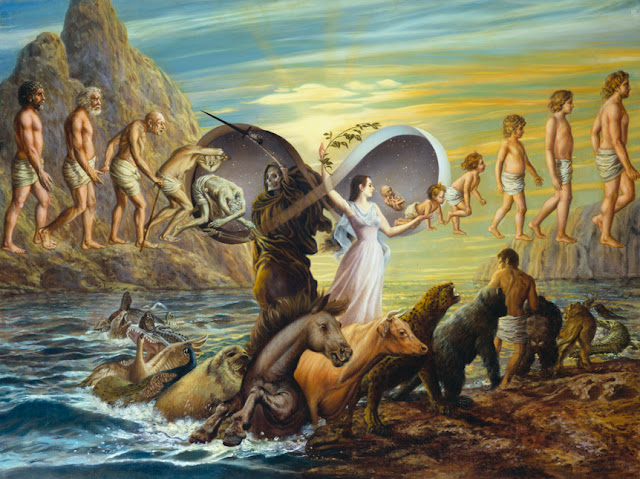What is Reincarnation?
Reincarnation, also called transmigration or metempsychosis,
in religion and philosophy, rebirth of the aspect of an individual that
persists after bodily death—whether it be consciousness, mind, the soul, or
some other entity—in one or more successive existences. Depending upon the
tradition, these existences may be human, animal, spiritual, or, in some instances,
vegetable. While belief in reincarnation is most characteristic of South Asian
and East Asian traditions, it also appears in the religious and philosophical
thought of local religions, in some ancient Middle Eastern religions (e.g., the
Greek Orphic mystery, or salvation, religion), Manichaeism, and gnosticism, as
well as in such modern religious movements as theosophy.
In many local religions, belief in multiple souls is common.
The soul is frequently viewed as capable of leaving the body through the mouth
or the nostrils and of being reborn, for example, as a bird, a butterfly, or an
insect. The Venda of southern Africa believe that, when a person dies, the soul
stays near the grave for a short time and then seeks a new resting place or
another body—human, mammalian, or reptilian.
Among the ancient Greeks, the Orphic mystery religion held
that a preexistent soul survives bodily death and is later reincarnated in a
human or other mammalian body, eventually receiving release from the cycle of
birth and death and regaining its former pure state. Plato, in the 5th–4th
century BCE, believed in an immortal soul that participates in frequent
incarnations.
The major religions that hold a belief in reincarnation,
however, are Asian religions, especially Hinduism, Jainism, Buddhism, and
Sikhism, all of which arose in India. They all hold in common a doctrine of
karma (karman; “act”), the law of cause and effect, which states that what one
does in this present life will have its effect in the next life. In Hinduism
the process of birth and rebirth—i.e., transmigration of souls—is endless until
one achieves moksha, or liberation (literally “release”) from that process.
Moksha is achieved when one realizes that the eternal core of the individual
(atman) and the Absolute reality (brahman) are one. Thus, one can escape from
the process of death and rebirth (samsara).
Jainism—reflecting a belief in an eternal and transmigrating
life principle (jiva) that is akin to an individual soul—holds that karma is a
fine particulate substance that settles upon the jiva according to the deeds
that a person does. Thus, the burden of the old karma is added to the new karma
that is acquired during the next existence until the jiva frees itself by
religious disciplines, especially by ahimsa (“nonviolence”), and rises to the
place of liberated jivas at the top of the universe.
Although Buddhism denies the existence of an unchanging,
substantial soul or self—as against the notion of the atman it teaches the
concept of anatman (Pali: anatta; “non-self”)—it holds to a belief in the
transmigration of the karma that is accumulated by an individual in life. The
individual is a composition of five ever-changing psycho-physical elements and
states, or skandhas (“bundles”)—i.e., form, sensations, perceptions, impulses,
and consciousness—and terminates with death. The karma of the deceased,
however, persists and becomes a vijnana (“germ of consciousness”) in the womb
of a mother. The vijnana is that aspect of consciousness that is reborn in a
new individual. By gaining a state of complete passiveness through discipline
and meditation, one can achieve nirvana, the state of the extinction of desires
and liberation (moksha) from bondage to samsara by karma.
Sikhism teaches a doctrine of reincarnation based on the
Hindu view but in addition holds that, after the Last Judgment, souls—which have
been reincarnated in several existences—will be absorbed in God.
See you all tomorrow.
Buh-bye.




Comments
Post a Comment